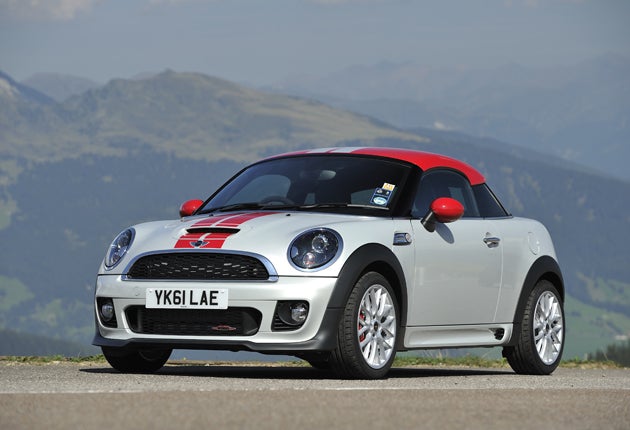Mini: John Cooper Works Coupé
After the Countryman comes the Coupé, and next up the Roadster. But are they still the real thing?

Oh, the power of a name.
The new Mini Coupé's greatest asset is also, paradoxically, its greatest liability. Call a car a Mini and there is really only one "look" it can have. It should also be small, because that is implicit in the name. Restrictive as they are to expanding a brand's reach, these attributes should be sacrosanct.
Or so you might think. The vast, five-door Mini Countryman's success suggests the buying public is less bothered by such brand nuances. In which case there is perhaps scope for another new shape of Mini, in the form of this chunky two-seater. Why, after all, should a modern brand be shackled by history? Better to break out and let it evolve.
A majority of current-Mini buyers are female. The Coupé is intended to masculinise the brand although to me it seems as inherently gender-neutral as any other Mini. To this end the racy stripes and contrasting roof colour are standard, although you can opt not to have them. Don't expect a price cut, though. The four most powerful engines from the current Mini range are offered here. Three are 1.6-litre petrol engines producing 122bhp or, with a turbocharger, 184bhp for the Cooper S and 211bhp for the John Cooper Works, and the fourth is a 143bhp turbodiesel with a hefty 2.0 litres' capacity. That seems massive for a Mini, but you can't argue with an official CO2 output of just 114g/km.
Whatever you think about the way it looks, the Mini Coupé does flow through the air more smoothly than the regular hatchback to the small benefit of pace and fuel thirst. The windscreen leans 13 degrees further back, and there's a spoiler on top of the boot which rises at 50mph and sinks again at 37mph. In the raised position, the spoiler makes the view aft even worse; thick rear pillars are a further major blind spot.
The boot, however, is bigger than that of any Mini-sized Mini to date, as it should be with just two seats ahead of it. They inhabit a cosy, well-finished cabin, dominated by a speedometer so vast that it's hard to assimilate its reading at a glance. Better to use the separate digital display instead.
In top John Cooper Works form the Coupé seems expensive at £23,795. But it is also impressively rapid, with an insistent rush of thrust right through the engine's speed range and a deep, enthusiastic exhaust note. All that thrust is channelled to the road with good discipline and excellent traction, even on a wet road, thanks to the electronic equivalent of a limited-slip differential achieved by selective braking of a wheel likely to spin. The same system helps keep the front wheels firmly nailed to your chosen cornering line, making the Mini feel very firmly planted on the road.
That said, the cheaper SD diesel model (£20,510), which has even more torque but less ultimate power, also sticks to the road even if it lacks the same degree of easy flickablility despite having equally quickly-responding steering. Actually, despite that "quickness" the steering is the least pleasing aspect of both Coupés; it is electrically powered with the sense of artificiality, tactile detachment and rubberiness around the straight-ahead position all too common in such systems.
Another advance in dynamics is in the way these Minis cope with bumps. I expected the SD to be acceptable here, notwithstanding the test car's optional 17-inch wheels whose tyres' shallow sidewalls made it thud over ridges, but previous JCWs have felt stiff, unyielding and tiresomely choppy. Work has been done here and this Coupé version has a flow over fast, bumpy roads absent hitherto.
Next year, the Mini massive will grow further with the arrival of the Roadster, effectively the Coupé but with a soft-top. Thus will the Mini morph into a sports car. Back in the early 1960s the whole point was that a Mini-Cooper could run rings round traditional sports cars of the day. All of which begs the question: should a Mini be sports car (or sports coupé), or should it just stay as a Mini? I think I'll leave that to the buying public.
The Rivals
Audi TT 2.0: from £27,130, 211bhp, 154g/km
Same power, lower CO2, bigger car, bigger price. The TT is just as much a fashion model, but offers a calmer, more grown-up drive.
Peugeot RCZ THP200: from £23,595, 200bhp, 159g/km
Obvious rival to Audi TT but uses 1.6-litre engine related to Mini's. Fast, handsome – and popular, as it's cheaper than the TT.
Renaultsport Megane 250: from £24,020, 250bhp, 190g/km
Performance-flavoured coupé reflecting the harder-core side of the Mini JCW's personality. One for the driving purist.
Subscribe to Independent Premium to bookmark this article
Want to bookmark your favourite articles and stories to read or reference later? Start your Independent Premium subscription today.

Join our commenting forum
Join thought-provoking conversations, follow other Independent readers and see their replies